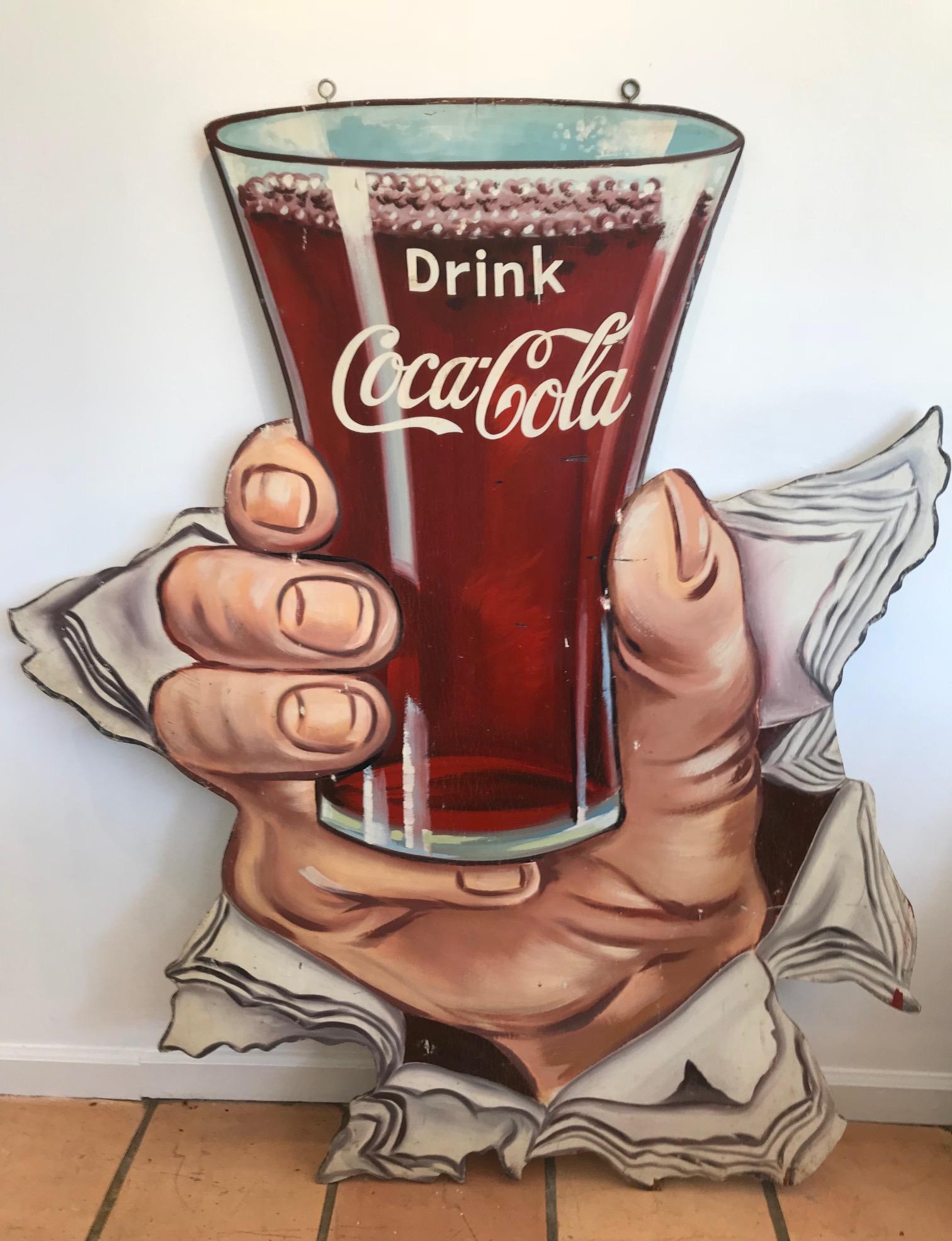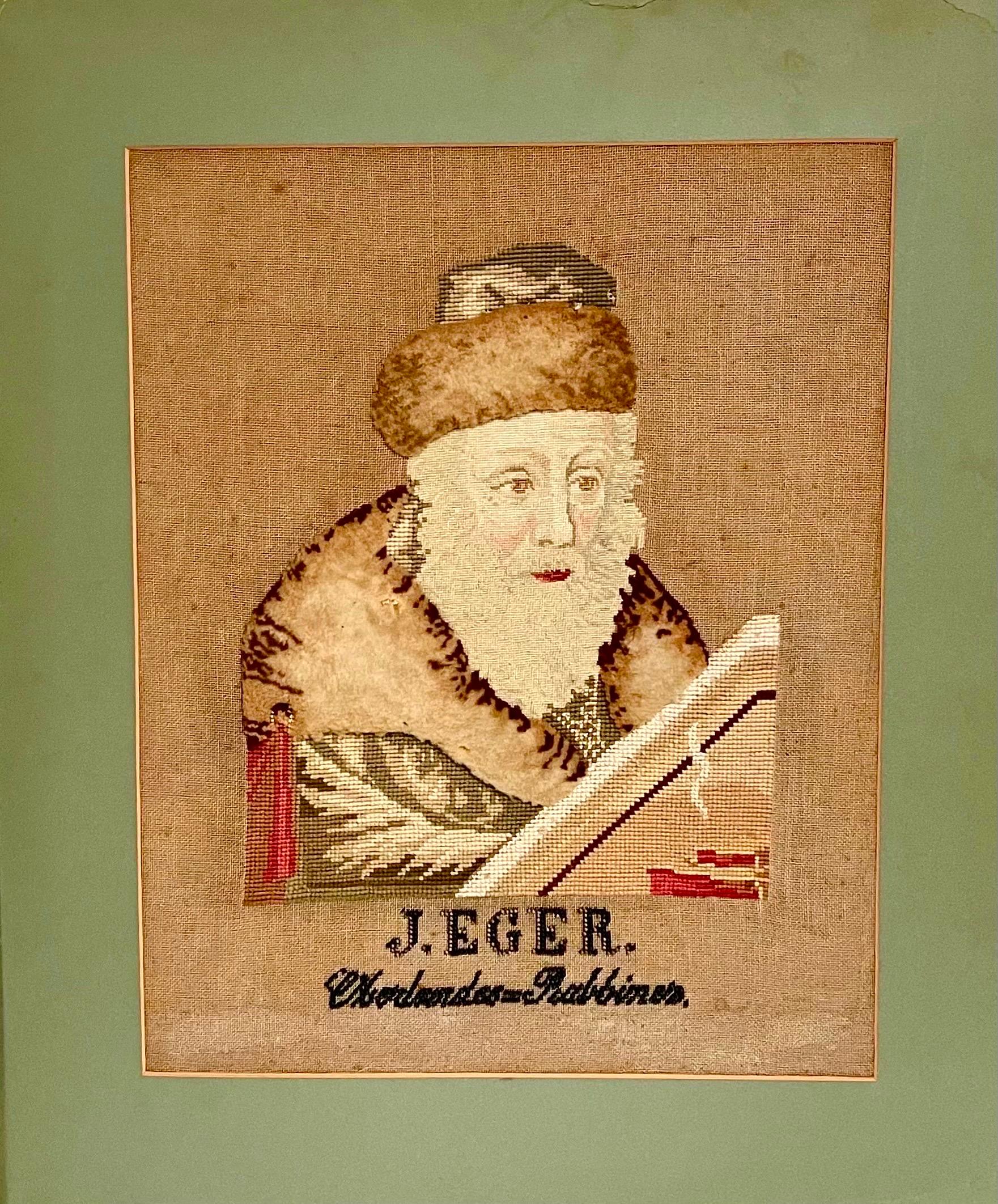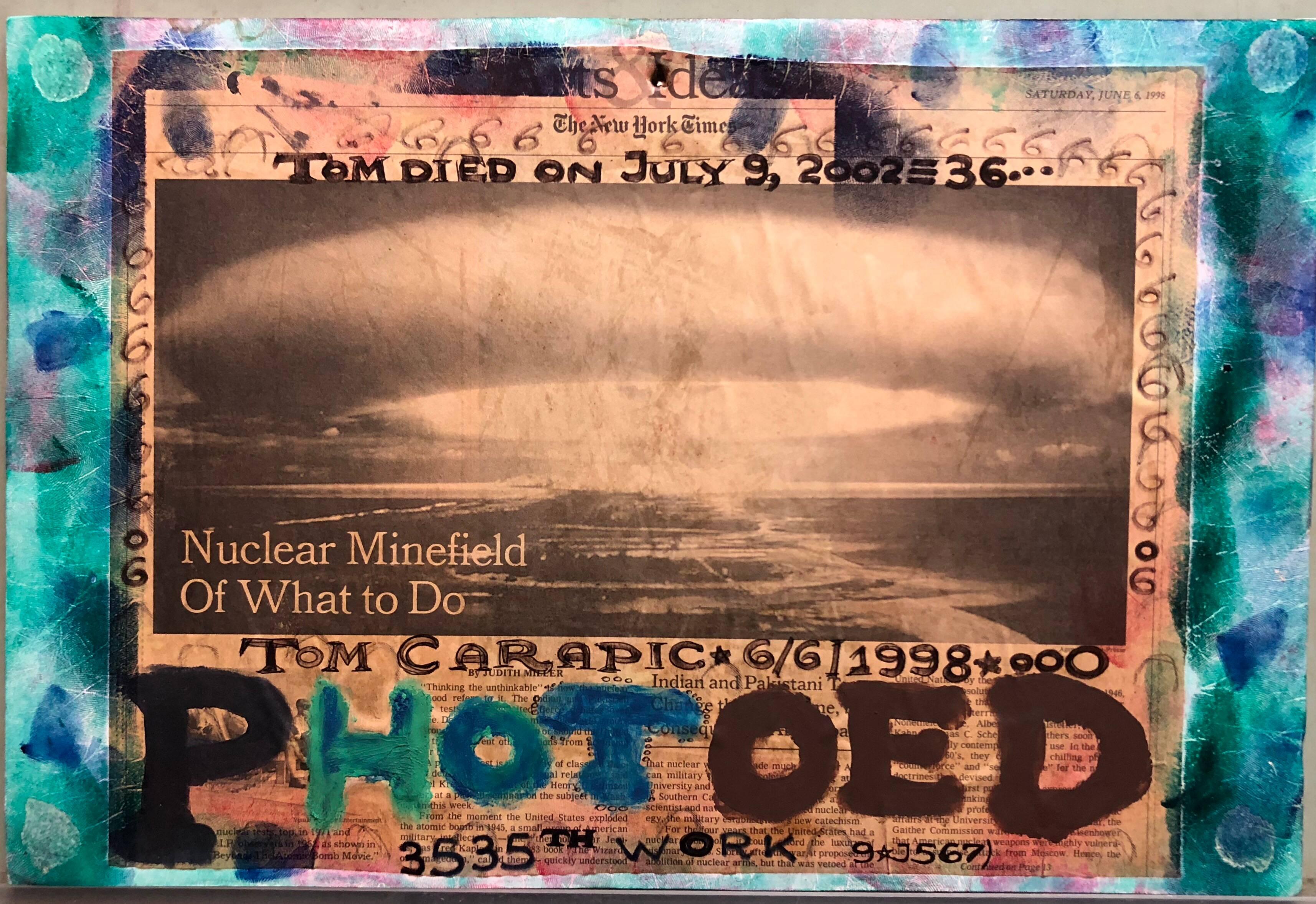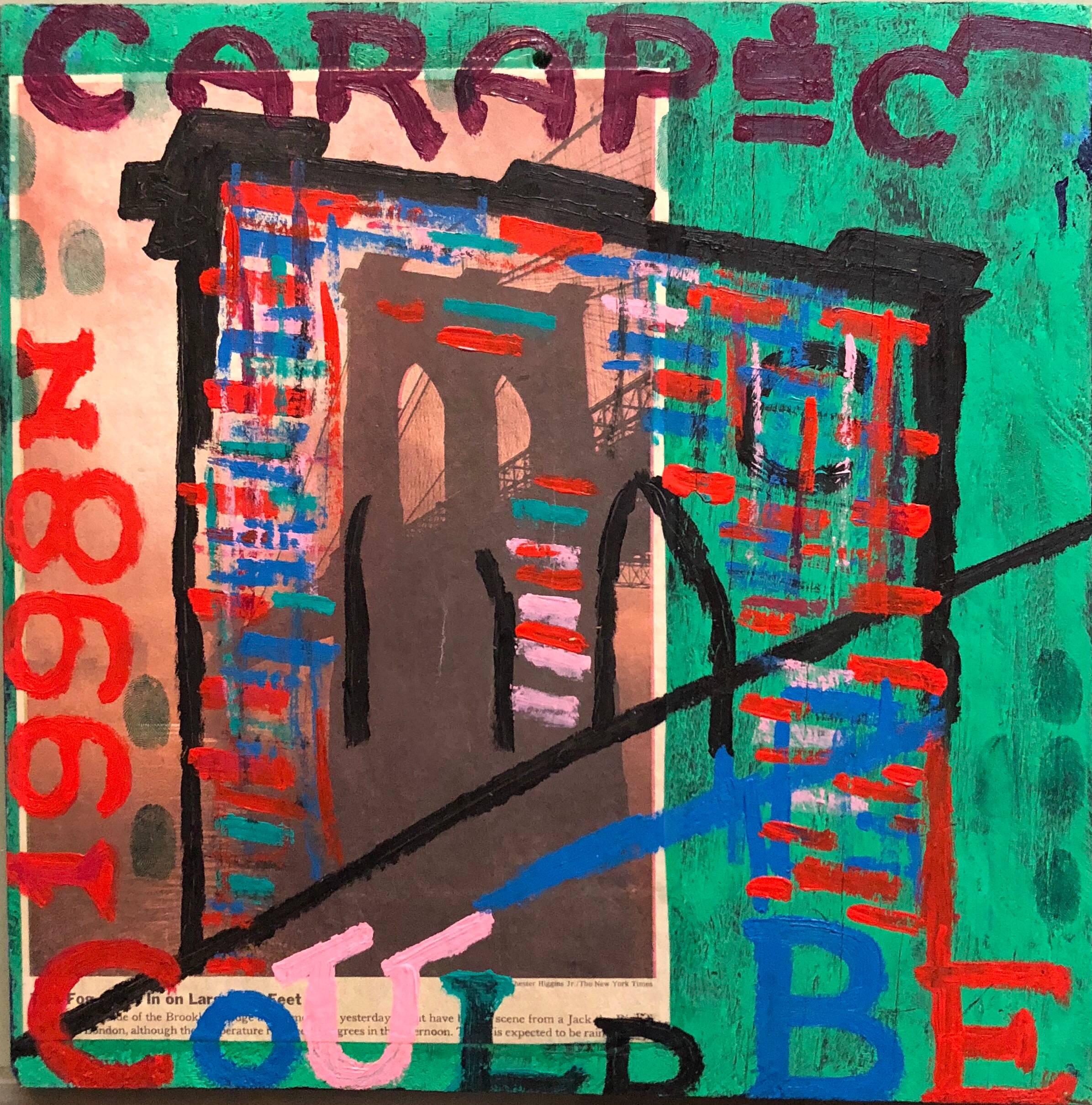Items Similar to Israeli Bird and Fish Hand Woven Itche Mambush Atelier Aubusson Style Tapestry
Want more images or videos?
Request additional images or videos from the seller
1 of 5
Sami BrissIsraeli Bird and Fish Hand Woven Itche Mambush Atelier Aubusson Style Tapestry
About the Item
This is an Aubusson style flat weave hand woven wool tapestry. This is from the Itche Mambush workshop. it is edition 2/5 (He worked with Mordechai Ardon, Marcel Janco, Abraham Rattner and others inspired By Jean Lurcat and Jean Picard le Doux)
Sami Briss (French/Roumanian/Israeli) Born May 18, 1930,
Jassy, Roumania (Jassy, Romania). Immigrated to Israel in 1960. Created
monumental works for the Weizmann Institute of Science in Rehovot, and for
Hadassah Hospital in Jerusalem. Since 1973 lives in Paris, France. His
works are in museum and private collections in Romania, West Germany,
France, Sweden, Holland, Luxembourg, Canada, U.S.A., etc. Sammi was born on
the 18th of May, 1930 in Jassey, Roumania. With the onset
of the Second World War, the family fled to Bucharest where Briss enrolled
at the "BeauxArts" Academy. Here he worked under Camil Ressu, a former
student of Gustave Moreau. After leaving the Academy, Briss, active mainly
as a printmaker, produced wooden sculptures and lithographs which were
widely published. These were, like his earlier still life paintings
reminiscent of the constructivism of George Braque and Cezanne. His
interpretation of nature and its beings also had a certain relationship to
the surrealism of his compatriot, Victor Brauner and the imagery of Paul Klee and André
Breton. However, Briss' work cannot be connected with any precise aesthetic
code as that of his contemporaries.
In 1959 Briss emigrated to Israel where he held his first Retrospective in
1967 at the Nathan Gallery in Tel Aviv. He is part of a generation of post war Israeli artists which include Yaacov Agam, Samuel Bak, Yosl Bergner, Naftali Bezem, Shmuel Katz, David Sharir, Calman Shemi, Jacob Steinhardt, Yossi Stern and Shraga Weil. Here Briss also painted several
murals in public buildings during the first half of the 70`s. It is at the beginning of the 60`s that he began painting in oil and watercolours in the "petits format" which he extended by creating Baroque montages, or works in glass frames decorated with velvet fabric or precious wood in the manner reminiscent of the religious icons so widespread in Russia, Bulgaria, and the churches of his native land.
Select solo shows: Galerie Romanet, Paris Galerie Art Actuel, Nancy Galerie Bellido, Den Haag Galerie F. Kohn Galerie le Hiboux, Luxembourg Galerie
Elca London, Montreal Safrai Gallery, Tel Aviv
Galerie Hoffman, Koln Galerie Amillis, Bruxelles Galerie du Forum, Reims Galerie Meissner, Hamburg Galerie Kishi, Osaka, Japan Noortman, Maastricht, Holland Hadassa K. Gallery, Tel Aviv Galerie St. Gilles, Liege Galerie Zur Krone, Switzerland Galerie D'Etraz, Lausanne Galerie Den
Bieman de Haas, Amsterdam Galerie D'Etraz, Lausanne Group exhibitions: Art Basel, Artexpo
New York, Artexpo Los Angeles,
This is an Aubusson Gobelin style wool tapisserie similar to Pinton, Tabard, Robert Four and other masterpiece workshops. these take months to make.
Sammy Briss art, which is connected to no precise
code of contemporary art, he calls upon varied legends to create his own
vocabulary of symbols.The fish appears in his works as the symbol of abundance, hands evoke
strength and happiness, and birds in flight emphasize a hope of detachment.
Based in his two kingdoms of Paris and Tel Aviv, the land of Israel is
evoked in Briss' paintings by the ruins of the temples. Briss' art depicts
a series of figures, some perturbed, some serene, while his paintings are
just as much dynamic as calm, complex and precise.
- Creator:Sami Briss (1930, French)
- Dimensions:Height: 56 in (142.24 cm)Width: 42 in (106.68 cm)
- Medium:
- Movement & Style:
- Period:
- Condition:
- Gallery Location:Surfside, FL
- Reference Number:1stDibs: LU38210731892
About the Seller
4.9
Platinum Seller
These expertly vetted sellers are 1stDibs' most experienced sellers and are rated highest by our customers.
Established in 1995
1stDibs seller since 2014
1,548 sales on 1stDibs
Typical response time: 1 hour
- ShippingRetrieving quote...Ships From: Surfside, FL
- Return PolicyA return for this item may be initiated within 3 days of delivery.
More From This SellerView All
- Woven Pictorial Blanket Tapestry by Brigitta BertoiaBy Brigitta Valentiner BertoiaLocated in Surfside, FLThis listing is for a "Picture Blanket" (hand crochet craft work) and also includes a small brochure and a signed offset lithograph print of a picture rug...Category
20th Century Folk Art More Art
MaterialsMixed Media
- Hungarian Rabbi Akiba Eger 19thC Judaica Folk Art Tapestry Needlepoint SamplerLocated in Surfside, FLDimensions board backing is 2 X 18.5 board opening is 16.5 X 13 inches 19th Century framed tapestry of a Rabbi, embroidered sampler, with beaded script below. (it reads J. Eger Oberlandes Rabbiner or Oberlander Rabbiner) There is some sort of texture and dimension to his fur hat (Shtreimel) and coat collar. This is being sold without the frame.. Rabbi Akiba Eger (5521-5598; 1761-1838) Rabbi Akiba Eger was one of the greatest scholars of his time, who had a great influence on Jewish life. He was born in Eisenstadt, Hungary, in the year 5521 (1761), nearly two hundred years ago. The city of his birth was a seat of learning for centuries, and his family was a family of scholars and Rabbis.Rabbi Akiba Eger, who was Rabbi in the famous community of Pressburg (also Hungary, but since 1913 it belonged to Czechoslovakia and was called Bratislava). He was invited to become Rabbi of the famous city of Posen, and in fact became the chief rabbi of the entire Posen province, though he did not carry that title. His famous son-in-law, Rabbi Moshe Sofer (known as the 'Chasam Sofer'), Rabbi of Pressburg, who had married Rabbi Akiba Eger's daughter. King Frederick III of Prussia honored him with a special medal. Rabbi Akiba Eger was recognized as a great authority on Jewish law, and many well known rabbis and Jewish leaders turned to him for advice and decisions on points of law. "This sort of art, craft work, emerges from a long tradition of Jewish folk art...Category
Early 1900s Folk Art More Art
MaterialsWool, Mixed Media, Thread
- Mixed Media Outsider Visionary Art Collage Twilight / Michael Jackson LaminatedBy Tom CarapicLocated in Surfside, FLThis one is laminated in plastic. Tom Carapic (born 1939), full name Tomislav Sava Čarapić, is an artist who specialises in found object artwork. He also does street art. A prominent Outsider Artist he was a featured artist in the American Visionary Art Museum's End is Near Exhibit. His work was also featured in the exhibition catalog. His work has been sold at Slotin Folk Art. Carapic was born in Velisevac, Serbia (then Kingdom of Yugoslavia). He was educated at a military school in Herzegovina in the 1950s, and served as a sergeant in the Yugoslav People's Army. Afterwards he was denied a college education, possibly because he was not a member of the Communist Party, illegally crossed into Italy in 1961, and, from there, emigrated to the United States. In 1965, he began attending classes at the New York Art Students League, but dropped out soon afterwards, eventually attending the Wilfred Academy of Beauty Culture. He was unable, however, to find steady beauty parlor employment, and worked in menial labor while attending classes in Spanish Education at Manhattan Community College. Due to a problem with accreditation, he was forced to switch to classes in the field of studio art. There he experienced hallucinatory visions that explained his repeated failures to obtain a degree. In the late 1970s, Carapic began experiencing more hallucinatory visions; claiming that his degree problems were caused when "the evil marriage bureau massed the troops" against his college and proceeded with "an Air force bombardment" of the school. After receiving other visitations, he began making and showing his art. Most of his art is centered on found objects, most famously computer keyboards, especially those by IBM. Most of his art consists of these objects, marked with black Sharpie markers, and with green thumbprints and handprints along the objects. His most famous exhibit in New York City is "Big Bang Theory," a doomsday warnings painted on computer keyboards and shoes and construction debris. Bears similarity to the Art Brut movement made famous by Jean Dubuffet. He was inluded in The End is Near! an exhibit which included an unprecedented group of noted thinkers, from His Holiness the Dalai Lama and Stephen Jay Gould to Reverend Howard Finster and Apocalypse culture expert ,Adam Parfrey, visionary artists brought together by curator, Roger Manley, for an amazing exhibition at the American Visionary Art Museum, the world’s largest ever mounted on the subjects of Apocalypse, Millennium, and Utopia. The End is Near! featuredwork from the following visionary artists amongst others: William Adkins Z.B. Armstrong Bill Bruley Frank Bruno Harry Leroy Brunson Tom Carapic Pierre Carbonel Howard Finster Tim Fowler Mary Mac Franklin Victor Joseph Gatto Robert Gie Patrick Gimel Hugo Hempel Oskar Herzberg Vojislav Jakic Norbert Kox Charles Keeling Lassiter...Category
20th Century Outsider Art Mixed Media
MaterialsMixed Media
- Mixed Media Outsider Visionary Art Newspaper Photo Collage 2 Sided LaminatedBy Tom CarapicLocated in Surfside, FLThis one is laminated in plastic. Tom Carapic (born 1939), full name Tomislav Sava Čarapić, is an artist who specialises in found object artwork. He also does street art. A prominent Outsider Artist he was a featured artist in the American Visionary Art Museum's End is Near Exhibit. His work was also featured in the exhibition catalog. His work has been sold at Slotin Folk Art. Carapic was born in Velisevac, Serbia (then Kingdom of Yugoslavia). He was educated at a military school in Herzegovina in the 1950s, and served as a sergeant in the Yugoslav People's Army. Afterwards he was denied a college education, possibly because he was not a member of the Communist Party, illegally crossed into Italy in 1961, and, from there, emigrated to the United States. In 1965, he began attending classes at the New York Art Students League, but dropped out soon afterwards, eventually attending the Wilfred Academy of Beauty Culture. He was unable, however, to find steady beauty parlor employment, and worked in menial labor while attending classes in Spanish Education at Manhattan Community College. Due to a problem with accreditation, he was forced to switch to classes in the field of studio art. There he experienced hallucinatory visions that explained his repeated failures to obtain a degree. In the late 1970s, Carapic began experiencing more hallucinatory visions; claiming that his degree problems were caused when "the evil marriage bureau massed the troops" against his college and proceeded with "an Air force bombardment" of the school. After receiving other visitations, he began making and showing his art. Most of his art is centered on found objects, most famously computer keyboards, especially those by IBM. Most of his art consists of these objects, marked with black Sharpie markers, and with green thumbprints and handprints along the objects. His most famous exhibit in New York City is "Big Bang Theory," a doomsday warnings painted on computer keyboards and shoes and construction debris. Bears similarity to the Art Brut movement made famous by Jean Dubuffet. He was inluded in The End is Near! an exhibit which included an unprecedented group of noted thinkers, from His Holiness the Dalai Lama and Stephen Jay Gould to Reverend Howard Finster and Apocalypse culture expert ,Adam Parfrey, visionary artists brought together by curator, Roger Manley, for an amazing exhibition at the American Visionary Art Museum, the world’s largest ever mounted on the subjects of Apocalypse, Millennium, and Utopia. The End is Near! featuredwork from the following visionary artists amongst others: William Adkins Z.B. Armstrong Bill Bruley Frank Bruno Harry Leroy Brunson Tom Carapic Pierre Carbonel Howard Finster Tim Fowler Mary Mac Franklin Victor Joseph Gatto Robert Gie Patrick Gimel Hugo Hempel Oskar Herzberg Vojislav Jakic Norbert Kox Charles Keeling Lassiter...Category
20th Century Outsider Art Mixed Media
MaterialsMixed Media
- Mixed Media Outsider Art Original Photo Collage Painting Brooklyn Bridge 2 SidedBy Tom CarapicLocated in Surfside, FLThis one is 2 sided with the Brooklyn Bridge on one side and Angkor Wat on the other side. (Angkor is one of the most important archaeological sites in South-East Asia. Stretching over some 400 km2, including forested area, Angkor Archaeological Park contains the magnificent remains of the different capitals of the Khmer Empire, from the 9th to the 15th century. They include the famous Temple of Angkor Wat and, at Angkor Thom, the Bayon Temple with its countless sculptural decorations.) Tom Carapic (born 1939), full name Tomislav Sava Čarapić, is an artist who specialises in found object artwork. He also does street art. A prominent Outsider Artist he was a featured artist in the American Visionary Art Museum's End is Near Exhibit. His work was also featured in the exhibition catalog. His work has been sold at Slotin Folk Art. Carapic was born in Velisevac, Serbia (then Kingdom of Yugoslavia). He was educated at a military school in Herzegovina in the 1950s, and served as a sergeant in the Yugoslav People's Army. Afterwards he was denied a college education, possibly because he was not a member of the Communist Party, illegally crossed into Italy in 1961, and, from there, emigrated to the United States. In 1965, he began attending classes at the New York Art Students League, but dropped out soon afterwards, eventually attending the Wilfred Academy of Beauty Culture. He was unable, however, to find steady beauty parlor employment, and worked in menial labor while attending classes in Spanish Education at Manhattan Community College. Due to a problem with accreditation, he was forced to switch to classes in the field of studio art. There he experienced hallucinatory visions that explained his repeated failures to obtain a degree. In the late 1970s, Carapic began experiencing more hallucinatory visions; claiming that his degree problems were caused when "the evil marriage bureau massed the troops" against his college and proceeded with "an Air force bombardment" of the school. After receiving other visitations, he began making and showing his art. Most of his art is centered on found objects, most famously computer keyboards, especially those by IBM. Most of his art consists of these objects, marked with black Sharpie markers, and with green thumbprints and handprints along the objects. His most famous exhibit in New York City is "Big Bang Theory," a doomsday warnings painted on computer keyboards and shoes and construction debris. Bears similarity to the Art Brut movement made famous by Jean Dubuffet. He was inluded in The End is Near! an exhibit which included an unprecedented group of noted thinkers, from His Holiness the Dalai Lama and Stephen Jay Gould to Reverend Howard Finster and Apocalypse culture expert ,Adam Parfrey, visionary artists brought together by curator, Roger Manley, for an amazing exhibition at the American Visionary Art Museum, the world’s largest ever mounted on the subjects of Apocalypse, Millennium, and Utopia. The End is Near! featuredwork from the following visionary artists amongst others: William Adkins Z.B. Armstrong Bill Bruley Frank Bruno Harry Leroy Brunson Tom Carapic Pierre Carbonel Howard Finster Tim Fowler Mary Mac Franklin Victor Joseph Gatto Robert Gie Patrick Gimel Hugo Hempel Oskar Herzberg Vojislav Jakic Norbert Kox Charles Keeling Lassiter...Category
20th Century Outsider Art Mixed Media
MaterialsPaint, Mixed Media, Photographic Paper
- Mixed Media Outsider Art Original Photo Collage Painting in Plastic Bag 2 SidedBy Tom CarapicLocated in Surfside, FLI think this one is the Chinese Premier on one side and fingerprints on the outside of the other side. wrapped in plastic. Tom Carapic (born 1939), full name Tomislav Sava Čarapić, is an artist who specialises in found object artwork. He also does street art. A prominent Outsider Artist he was a featured artist in the American Visionary Art Museum's End is Near Exhibit. His work was also featured in the exhibition catalog. His work has been sold at Slotin Folk Art. Carapic was born in Velisevac, Serbia (then Kingdom of Yugoslavia). He was educated at a military school in Herzegovina in the 1950s, and served as a sergeant in the Yugoslav People's Army. Afterwards he was denied a college education, possibly because he was not a member of the Communist Party, illegally crossed into Italy in 1961, and, from there, emigrated to the United States. In 1965, he began attending classes at the New York Art Students League, but dropped out soon afterwards, eventually attending the Wilfred Academy of Beauty Culture. He was unable, however, to find steady beauty parlor employment, and worked in menial labor while attending classes in Spanish Education at Manhattan Community College. Due to a problem with accreditation, he was forced to switch to classes in the field of studio art. There he experienced hallucinatory visions that explained his repeated failures to obtain a degree. In the late 1970s, Carapic began experiencing more hallucinatory visions; claiming that his degree problems were caused when "the evil marriage bureau massed the troops" against his college and proceeded with "an Air force bombardment" of the school. After receiving other visitations, he began making and showing his art. Most of his art is centered on found objects, most famously computer keyboards, especially those by IBM. Most of his art consists of these objects, marked with black Sharpie markers, and with green thumbprints and handprints along the objects. His most famous exhibit in New York City is "Big Bang Theory," a doomsday warnings painted on computer keyboards and shoes and construction debris. Bears similarity to the Art Brut movement made famous by Jean Dubuffet. He was inluded in The End is Near! an exhibit which included an unprecedented group of noted thinkers, from His Holiness the Dalai Lama and Stephen Jay Gould to Reverend Howard Finster and Apocalypse culture expert ,Adam Parfrey, visionary artists brought together by curator, Roger Manley, for an amazing exhibition at the American Visionary Art Museum, the world’s largest ever mounted on the subjects of Apocalypse, Millennium, and Utopia. The End is Near! featuredwork from the following visionary artists amongst others: William Adkins Z.B. Armstrong Bill Bruley Frank Bruno Harry Leroy Brunson Tom Carapic Pierre Carbonel Howard Finster Tim Fowler Mary Mac Franklin Victor Joseph Gatto Robert Gie Patrick Gimel Hugo Hempel Oskar Herzberg Vojislav Jakic Norbert Kox Charles Keeling Lassiter...Category
20th Century Outsider Art Mixed Media
MaterialsMixed Media
You May Also Like
- Coca-Cola sign - Unique Hand-Painted Wood Coke Sign - "Drink Coca-Cola" c 1950sLocated in New York, NYA vintage, one of a kind hand painted wooden sign ca. 1950s or 1960s for Coca-Cola Company. Beautifully painted and rendered image of a classic cola filled soda glass in hand reading...Category
Mid-20th Century Folk Art More Art
MaterialsWood, Mixed Media
- Necklace With Cameo Depicting Vesuvius. Late 19th. NaplesLocated in Firenze, ITNecklace with cameo depicting Vesuvius. Antique cameo, hand carved at the end of the 19th century. Central cameo with filigree cast, size h cm 2.5, L 3cm. Hand-engraved cameo on she...Category
Late 19th Century Folk Art More Art
MaterialsGlass, Intaglio
- Rare Vesuvius Lava Stone Writing Set. torre Del Greco (naples). XIXLocated in Firenze, ITVery Rare Vesuvius lava stone writing set. Torre del Greco (Naples). 19th century. 4 objects with small sculptures (cameos) depicting the poet Petrarch, mythological female figures, ...Category
Mid-19th Century Folk Art More Art
MaterialsStone, Brass
- "Protector One" Folk Art Crow SculptureLocated in Chicago, ILRichly textured with whimsical appeal, this late 20th century wooden crow is a delightful example of naive American sculpture. Poised mid-caw, the crow's wings are outstretched, read...Category
Late 20th Century Folk Art Figurative Sculptures
MaterialsWood, Paint
- Framed Hmong Appliqué Textile FragmentLocated in Chicago, ILDating to the mid-20th century, this colorful Hmong textile is a classic example of the appliqué technique used for the traditional cloth known as paj n...Category
Mid-20th Century Folk Art More Art
MaterialsTextile
- "Yesterday, " Mixed-Media Sculpture, 2019Located in Chicago, ILTo Chicago-based artist Patrick Fitzgerald, his sculptures are a means of traveling through time. Working from found materials, Fitzgerald constructs miniature soap box cars and the ...Category
21st Century and Contemporary Outsider Art Figurative Sculptures
MaterialsMetal
Recently Viewed
View AllMore Ways To Browse
Atelier Vintage Art
Atelier Vintage Paris
Israel Art Museums
Early Israeli Art
Galerie May
Hand Painted Bird Artist
60s And 70s Art
Woven Fabric Art
Fish And Bird
Public Works 1930s Art
Vintage Style Tapestry
Russian Icon Art
Israel Glass
Israel War Art
Constructivism Art
New French Tapestry
Swiss Atelier
Israel Art Glass





